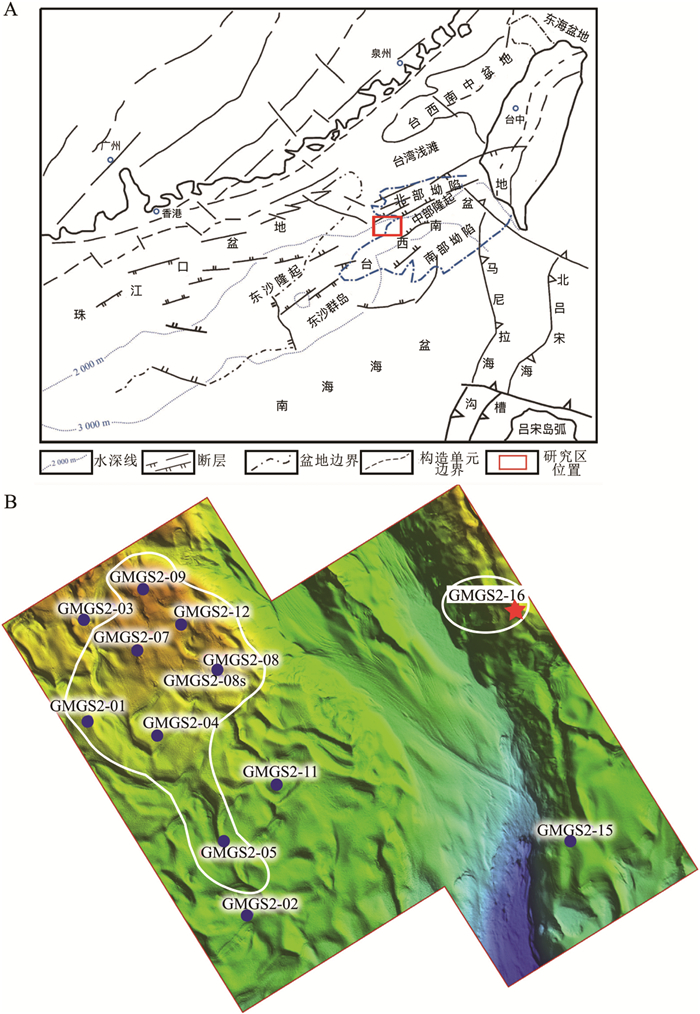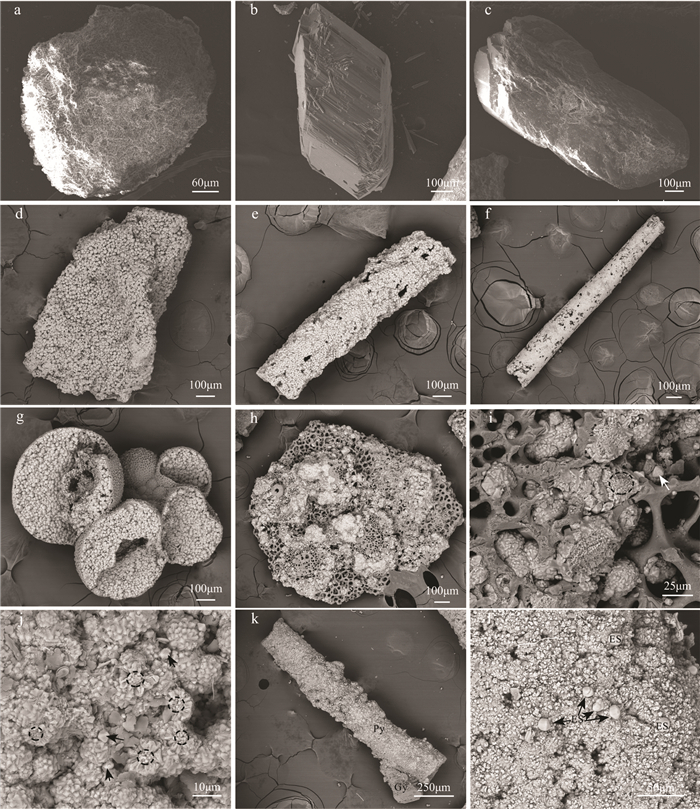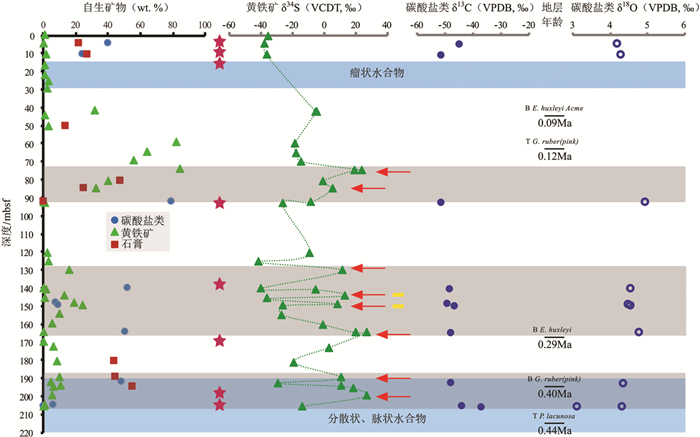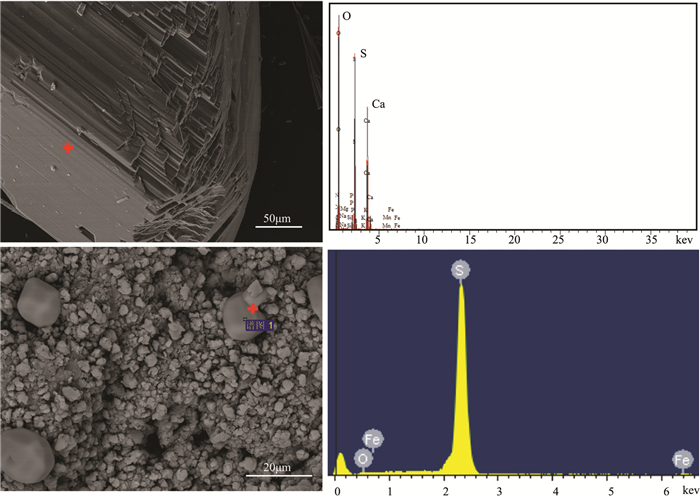Authigenic minerals at site GMGS2-16 of northeastern South China Sea and its implications for gas hydrate evolution
-
摘要: 硫酸盐-甲烷转换带(SMTZ)是海洋富甲烷沉积环境中重要的生物地球化学分带,其内发生的甲烷厌氧氧化反应(AOM)通常能影响多种自生矿物(碳酸盐类、黄铁矿、重晶石和石膏等)的形成过程。本文选取南海东北部天然气水合物赋存区GMGS2-16站位的58个沉积物样品,对其中发育的自生矿物进行了类型、含量、分布、显微形貌和稳定同位素研究。GMGS2-16站位岩心沉积物中主要发育碳酸盐类、黄铁矿和石膏3类自生矿物,亦发现单质硫颗粒的存在。自生矿物含量分布变化较大,存在多个富集层位。自生碳酸盐类均为块状,具极负的δ13C值(-37.3‰~-51.7‰ VPDB)和较重的δ18O值(3.13‰~4.95‰ VPDB),指示其为甲烷碳源,即AOM成因。自生黄铁矿主要呈不规则块状、棒状-管状和生物充填状,δ34S值变化范围为-41.7‰~27.1‰ VCDT,其中δ34S值异常正偏很可能与大量甲烷流体上涌至SMTZ内加强AOM反应有关。多层AOM成因的自生碳酸盐类与δ34S值异常的自生黄铁矿产出层位基本吻合,共同指示了研究站位曾发生过多期次甲烷渗漏事件,可能与研究站位天然气水合物藏失稳存在一定联系。自生石膏主要呈棱柱状和透镜状,偶见黄铁矿-石膏共生体,初步推测自生石膏可能与水合物形成过程中的排离子效应和(或)沉积环境氧化还原条件改变导致的黄铁矿氧化有关。因此,海洋沉积物中碳酸盐类-黄铁矿-石膏自生矿物组合对探讨古海洋甲烷渗漏事件和天然气水合物藏的演化具有重要指示意义。Abstract: The sulfate-methane transition zone (SMTZ) is a pivotal biogeochemical zone within an anoxic sediment column, in which anaerobic oxidation of methane (AOM) may affect the formation of authigenic minerals, such as carbonate, pyrite, barite and gypsum. In this paper, authigenic minerals in 58 marine sediment samples from site GMGS2-16 at the gas hydrate drilling area in the northeastern South China Sea were analyzed. We investigated the type, content, distribution, morphology and isotopic composition of the authigenic minerals to explore the formation mechanism of them and their implications for methane events. Carbonate, pyrite and gypsum are the three dominant authigenic minerals at site GMGS2-16, and also found is the presence of elemental sulfur particles. The distribution of the authigenic mineral contents varies greatly and shows several high concentration peaks. The authigenic carbonates are formed in irregular clumps. These carbonates have extremely negative carbon isotope (-37.3‰ VPDB~-51.7‰ VPDB) and heavy oxygen isotope compositions (3.13‰ VPDB~4.95‰ VPDB), which are typical characteristics of methane-derived carbonates, suggesting that AOM is the trigger for carbonate precipitation. Authigenic pyrites are mostly in forms of irregular masses, rod-tube and organism-filling aggregates. The sulfur isotopic values (δ34S) of the authigenic pyrites range from -41.7‰ VCDT to 27.1‰ VCDT. Anomalously positive excursions of sulfur isotopic values probably stem from enhanced-AOM in the SMTZ because of high methane flux. The AOM-derived authigenic carbonates are basically consistent with the δ34S-anomaly authigenic pyrite production, indicating the occurrence of episodic methane events, which may be related to natural gas hydrate dissociation at site GMGS2-16. Authigenic gypsums occur as hyaline prisms more or less elongated and as dull prismatic or lenticular crystals, and some of them are attached to the authigenic pyrites. We tentatively propose that the precipitation of the authigenic gypsums results from ion exclusion during the formation of gas hydrates and/or pyrite oxidation caused by the change in environmental redox conditions. Hence, carbonate- pyrite-gypsum authigenic mineral assemblage in marine sediments may have the possibility to be used as a proxy for development of natural gas hydrate.
-
硫酸盐-甲烷转换带(Sulfate-Methane Transition Zone, SMTZ)是海洋沉积物中重要的生物地球化学分带,不仅是沉积层中的氧化-还原界面,亦是硫酸盐还原细菌(Sulfate Reducing Bacteria, SRB)与产甲烷菌(Methanogens)生长环境的分界线(图 1)。在SMTZ内,硫酸盐还原菌与甲烷厌氧氧化古菌(Anaerobic Methanotrophic archaea, ANME)共生[1, 2],形成一种独特的成岩环境[3]。下渗海水中的硫酸根离子(SO42-)与上涌流体中的甲烷(CH4)在SMTZ内发生甲烷厌氧氧化反应(Anaerobic Oxidation of Methane, AOM)(式1;图 1)[4],此过程可能消耗了>90%的由海洋沉积物深部向海底渗漏的甲烷,有效减少了温室气体甲烷向大气释放[5, 6]。
![]() 图 1 甲烷渗漏区浅表层沉积物的主要成岩过程示意图(据文献[3])Figure 1. Schematic figure of the major diagenetic reactions in shallow sediments at the methane seepage area
图 1 甲烷渗漏区浅表层沉积物的主要成岩过程示意图(据文献[3])Figure 1. Schematic figure of the major diagenetic reactions in shallow sediments at the methane seepage area$$ {\text{C}}{{\text{H}}_{\text{4}}} + {\text{SO}}_{\text{4}}^{{\text{2 - }}} \to {\text{HCO}}_{\text{3}}^{\text{ - }} + {\text{H}}{{\text{S}}^{\text{ - }}} + {{\text{H}}_{\text{2}}}{\text{O}} $$ (1) $$ 2 \mathrm{HCO}_{3}^{-}+\mathrm{Ca}^{2+} \rightarrow \mathrm{CaCO}_{3}+\mathrm{CO}_{2}+\mathrm{H}_{2} \mathrm{O} $$ (2) $$ \mathrm{HS}^{-}+\mathrm{Fe}^{2+} \rightarrow \mathrm{FeS} \rightarrow \mathrm{FeS}_{2} $$ (3) 当上涌的含甲烷流体的通量发生变化时,SMTZ位置会在海洋沉积物内发生迁移:高甲烷通量能导致线性硫酸盐浓度梯度和浅的SMTZ,反之亦然[7, 8]。当沉积物孔隙流体中出现异常高的甲烷浓度,即甲烷渗漏事件发生时,SMTZ内的AOM反应会得到加强,从而促进孔隙流体中HS-和HCO3-的富集,进而造成碳酸盐类矿物和铁硫化物的沉淀(式1, 2, 3)[9-13]。另外,在水合物赋存区,硫酸盐类矿物(重晶石、石膏等)的沉淀和溶解也可能与甲烷流体通量变化有关,很大程度上可反映SMTZ的演化过程[14-16]。重晶石的富集常被用来指示古硫酸盐-甲烷转换带(Paleo-SMTZ)的位置[14, 17]。
由于直接测量地史时期沉积物中甲烷流体通量和SMTZ深度随时间的变化在本质上是不可能的,故而海洋沉积物中与AOM过程直接或间接相关的自生矿物被视为指示SMTZ演化和甲烷流体通量变化的有效示踪剂[14, 18, 19]。目前,利用自生矿物识别SMTZ的方式非常多样,如钡异常、自生碳酸盐δ13C值、黄铁矿含量及其δ34S值、磁异常、黄铁矿莓球粒径异常、微量元素异常等[3, 11, 20-25]。
广州海洋地质调查局于2013年实施的南海北部第二次天然气水合物钻探(GMGS2)中有5个站位成功获取了大量水合物实物样品。其中,GMGS2-16站位发育瘤状和分散状、脉状水合物, 兼具渗漏型和扩散型水合物成藏特征[26]。该站位是GMGS2航次地层年代数据最多、识别出的生物事件最多的站位[27]。因此,GMGS2-16站位沉积物样品是研究天然气水合物地质系统中自生矿物特征的良好材料。本文通过分析GMGS2-16站位沉积物中自生矿物类型、含量、分布、显微形貌和稳定同位素特征,探讨了自生矿物的成因机制及其对甲烷渗漏事件的指示意义。
1. 样品来源与处理方法
1.1 研究站位地质背景
南海是西太平洋和亚洲东南部最大的边缘海之一,受到欧亚板块、太平洋板块和印澳板块的共同作用,具独特的构造-沉积特征,南海北部陆缘为被动型大陆边缘,发育海槽、海山和一系列沉积盆地(例如,台西南盆地、珠江口盆地、琼东南盆地),而向东逐渐过渡至活跃的碰撞性大陆边缘[28, 29]。目前,南海东北部陆坡是中国水合物资源最为丰富、成藏地质条件最为复杂的成矿区之一[26]。台西南盆地位于台湾西南海域,是中新生代叠合型或残留复合型断陷裂谷盆地[30]。此处广泛存在似海底反射层、泥底辟、泥火山、断层和冲断褶皱带,具良好的油气疏导体系[31]。2013年6—9月,中国地质调查局、广州海洋地质调查局与辉固国际集团、英国GEOTEK合作使用M/V REM Etive钻探船,在台西南盆地中部隆起钻探了13个站位(图 2A),包括10个站位的随钻测井(Logs While Drilling, LWD)和3个站位的有缆测井(Wireling Logs, WLL)[32],13个站位中的5个站位取心获取了大量层状、块状、结核状和分散状等天然气水合物实物样品,甲烷气体含量超过99%[33]。
GMGS2-16站位位于东部海脊高部位(图 2B),水深871m,发育独特的双层水合物:15~30mbsf(meters below sea floor,海底以下深度)内发育瘤状水合物;189~226mbsf内发育分散状、脉状水合物[33, 34]。
取心最大深度为213.55m,通过识别钙质超微化石事件和有孔虫事件确定钻孔钻达的最老地层时代在0.44Ma左右,即中更新统[27]。该站位甲烷δ13C值为-70.7‰~-69.9‰,认为其来源主要为生物成因气[26]。
1.2 样品预处理与测试方法
GMGS2-16站位沉积物样品于2015年底取自广州海洋地质调查局岩心库,岩心以约1~8m间隔取样58个。取得的样品全部转移到中国地质大学(武汉)生物地质与环境地质国家重点实验室,置于冰柜中低温保存,预处理之前在室温下解冻,预处理具体步骤如下[36]:
(1) 利用取样器对沉积物样品定体积(约10cc)取样,称量得其湿样重后置于恒温箱(50℃)中24h,得其干样重;
(2) 烘干样品加蒸馏水浸泡12~24h,使其充分分散;
(3) 叠放使用孔径为65和30.8μm的标准筛筛洗样品,先在蒸馏水冲洗下用刷子轻刷样品,然后使用超声波清洗仪震荡约20s,将上清液倒出后再加入适量蒸馏水,重复冲洗至干净为止;
(4) 冲洗干净的样品置于恒温箱(50℃)中烘干,之后将粗组分(粒径≥65μm)和细组分(粒径分布范围为65~30.8μm)称量后分别转入容器中密封存放。
预处理完成后,在双目体视镜下观察粗组分,根据研究需要进行自生矿物的鉴定和挑选。自生矿物相对含量均以其与粗组分的质量比来表示,如碳酸盐相对含量(wt.%)=100%×碳酸盐质量/粗组分质量。样品处理过程中,用水皆为去离子水,所有工具使用前均进行清洗,后用高压气枪吹干,防止样品间的交叉污染。
自生矿物的扫描电子显微镜观察(Scanning Electron Microscope, SEM)在中国地质大学(武汉)地质生物地质与环境地质国家重点实验室和地质过程与矿产资源国家重点实验室完成,仪器型号分别为SU8010和FEI Quanta 450 FEG。黄铁矿的硫同位素测试在中国地质大学(武汉)生物地质与环境地质国家重点实验室完成,测试仪器为元素分析-同位素比值质谱仪(DELTA V PLUS),数据经国际标准物质(IAEA-S1(-0.3‰), IAEA-S2(22.7‰), IAEA-S3(22.7‰))校正至VCDT(Vienna-defined Canyon Diablo Troilite)标准,测试标准偏差<0.2‰。自生碳酸盐类矿物的碳、氧稳定同位素在中国地质大学(武汉)地质过程与矿产资源国家重点实验室完成,仪器为气相色谱-热转换同位素比值质谱仪,仪器型号为MAT253,分析检测精度为:δ13C<0.04‰, δ18O<0.07‰,数据由国际标样校正至VPDB(Vienna Pee Dee Belemnite)。
2. 结果
2.1 自生矿物类型、含量分布与显微形貌
GMGS2-16站位岩心沉积物中发育的自生矿物主要为碳酸盐类、黄铁矿和石膏(图 3)。自生碳酸盐类在岩心沉积物中的多个层位内富集,分别位于约5~10、90、140~150、165、190和205mbsf(图 4),其形貌基本为不规则块状(图 3a)。
![]() 图 3 GMGS2-16站位自生矿物显微形貌a.自生碳酸盐类; b.棱柱状石膏; c.透镜状石膏; d.不规则块状黄铁矿; e.管状黄铁矿; f~i.生物壳体充填的黄铁矿:f.可能是由贝氏硫细菌被黄铁矿充填而形成, g.有孔虫壳体充填的黄铁, h.放射虫壳体充填的黄铁矿; i~j为h的局部放大, 可见黄铁矿莓球的二次生长现象(黑色闭合虚线为内核和次生加大边的分界线)和自形的八面体微晶(箭头); k.黄铁矿-石膏共生体; l.黄铁矿表面的单质硫颗粒Figure 3. SEM images of authigenic minerals from site GMGS2-16a. Authigenic carbonate; b. Gypsum crystal in rhombic shape; c. Gypsum crystal in lenticular shape; d. Irregular massive pyrite aggregates; e. Tube-like pyrite aggregates; f~i. Organism-filling pyrite aggregates: f. Maybe pseudomorphous after Beggiatoa, g. Pyrite aggregation filling in chambers of the foraminiferan test, h. Pyrite aggregation filling in chambers of the radiolarian test; i~j. Enlarged image of h, pyrite aggregates with a secondary radial growth layer (outside black dashed circle) surrounding a core of framboidal pyrite (inside black dashed circle) and euhedral pyrite crystals (arrows); k. A gypsum attached to a pyrite rod; l. Elemental sulfur on the surface of pyrite aggregates
图 3 GMGS2-16站位自生矿物显微形貌a.自生碳酸盐类; b.棱柱状石膏; c.透镜状石膏; d.不规则块状黄铁矿; e.管状黄铁矿; f~i.生物壳体充填的黄铁矿:f.可能是由贝氏硫细菌被黄铁矿充填而形成, g.有孔虫壳体充填的黄铁, h.放射虫壳体充填的黄铁矿; i~j为h的局部放大, 可见黄铁矿莓球的二次生长现象(黑色闭合虚线为内核和次生加大边的分界线)和自形的八面体微晶(箭头); k.黄铁矿-石膏共生体; l.黄铁矿表面的单质硫颗粒Figure 3. SEM images of authigenic minerals from site GMGS2-16a. Authigenic carbonate; b. Gypsum crystal in rhombic shape; c. Gypsum crystal in lenticular shape; d. Irregular massive pyrite aggregates; e. Tube-like pyrite aggregates; f~i. Organism-filling pyrite aggregates: f. Maybe pseudomorphous after Beggiatoa, g. Pyrite aggregation filling in chambers of the foraminiferan test, h. Pyrite aggregation filling in chambers of the radiolarian test; i~j. Enlarged image of h, pyrite aggregates with a secondary radial growth layer (outside black dashed circle) surrounding a core of framboidal pyrite (inside black dashed circle) and euhedral pyrite crystals (arrows); k. A gypsum attached to a pyrite rod; l. Elemental sulfur on the surface of pyrite aggregates![]() 图 4 GMGS2-16站位沉积物中自生矿物含量、碳-氧-硫稳定同位素组成、单质硫发育特征和推测的古硫酸盐-甲烷转换带(Paleo-SMTZ)存在位置暗玫红色五角星指示Gong等(2017)[38]描述的GMGS2-16站位自生碳酸盐类矿物产出层位; 红色箭头指示自生黄铁矿δ34S值出现异常正偏的层位; 黄色矩形指示单质硫矿物产出层位; 灰色阴影部分指示推测的古硫酸盐-甲烷转换带位置; 地层年龄数据来自陈芳等(2016)[27]Figure 4. Contents and carbon-oxygen-sulfur isotope compositions of authigenic minerals, distribution of elemental sulfur and locations of the Paleo-SMTZsDark rose red stars represent the positions of authigenic carbonate described by Gong et al. (2017)[38]; Red arrows represent the positions of anomalously positive excursions of δ34S; Yellow rectangles represent the positions of elemental sulfur; grey shade areas represent the locations of the Paleo-SMTZs; Stratigraphic age data from Chen et al. (2016)[27]
图 4 GMGS2-16站位沉积物中自生矿物含量、碳-氧-硫稳定同位素组成、单质硫发育特征和推测的古硫酸盐-甲烷转换带(Paleo-SMTZ)存在位置暗玫红色五角星指示Gong等(2017)[38]描述的GMGS2-16站位自生碳酸盐类矿物产出层位; 红色箭头指示自生黄铁矿δ34S值出现异常正偏的层位; 黄色矩形指示单质硫矿物产出层位; 灰色阴影部分指示推测的古硫酸盐-甲烷转换带位置; 地层年龄数据来自陈芳等(2016)[27]Figure 4. Contents and carbon-oxygen-sulfur isotope compositions of authigenic minerals, distribution of elemental sulfur and locations of the Paleo-SMTZsDark rose red stars represent the positions of authigenic carbonate described by Gong et al. (2017)[38]; Red arrows represent the positions of anomalously positive excursions of δ34S; Yellow rectangles represent the positions of elemental sulfur; grey shade areas represent the locations of the Paleo-SMTZs; Stratigraphic age data from Chen et al. (2016)[27]自生黄铁矿的相对含量亦存在不均匀分布的现象,富集层位为40~90、130~155和190~195mbsf(图 4)。自生黄铁矿主要有3种形貌:不规则块状(图 3d)、棒状-管状(图 3e)和生物充填状(图 3f~i),其中不规则块状最常见,次为棒状,有孔虫、放射虫等生物充填的黄铁矿最少,但在75~80mbsf层位内大量出现放射虫壳体充填的黄铁矿集合体,可能与微环境的变化有关。黄铁矿微晶主要为八面体单晶及其组成的莓球状黄铁矿,莓球或松散分布或紧密堆积,在部分破损的黄铁矿莓球截面上可见二次生长现象(图 3i~j),即球状黄铁矿微晶内核外出现次生加大边,放射状分布形成增生环带,黄铁矿莓球周围还可见自形的黄铁矿微晶。少部分样品可见黄铁矿与石膏共生的现象(图 3k)。
在GMGS2-16站位岩心沉积物中还出现了自生石膏的多层位富集,分别位于约5~10、50、80~90和180~195mbsf(图 4)。除5~10mbsf石膏富集层外,其余石膏富集层基本位于天然气水合物层之上、自生黄铁矿富集层之下,该情况与Lin等(2016)[15]所描述的一致。该站位产出的石膏大多呈棱柱状和透镜状(图 3b-c,图 5),粒径约为10mm。前者具占主体性的{010}晶面,表面发育解理纹;后者具加长的{111}晶面和{110}晶面。
GMGS2-16站位仅在2个样品中发现单质硫颗粒(图 3l,图 5),深度分别为144.2和148.6mbsf。单质硫颗粒呈球形-椭球形,直径约10~15μm,无明显的晶形,均分布于黄铁矿的表层,此前南海北部(973-2和973-4站位)沉积物中已有单质硫颗粒发现[37]。
2.2 自生矿物稳定同位素组成
GMGS2-16站位岩心沉积物中发育的多套自生碳酸盐类矿物均具极负的δ13C值,变化范围为-37.3‰~-51.7‰ VPDB,其δ18O值较正,分布在3.13‰~4.95‰ VPDB之间(图 4)。自生黄铁矿的δ34S值变化范围为-41.7‰~27.1‰ VCDT,在74~85、130~165、190~200mbsf深度范围内出现明显正偏(图 4)。
3. 讨论
3.1 自生碳酸盐类矿物成因探讨
自生碳酸盐类矿物在海洋沉积环境中分布十分广泛,是沉积物中孔隙水碱度上升、溶解无机碳(Dissolved Inorganic Carbon, DIC)过饱和时矿物结晶、沉淀的产物。自生碳酸盐类矿物的同位素特征继承于其形成时的DIC库,因此,可反映其形成过程中的碳来源[3, 39]。
海洋沉积物中孔隙流体的DIC主要有3种来源:(1)生物成因甲烷,δ13C大致分布在-50‰~-110‰ VPDB之间[40];或热解成因甲烷,δ13C分布在-30‰~-50‰ VPDB之间[41];(2)沉积有机碳,δ13C值在-25‰ VPDB左右或更正;(3)生物成因碳酸盐,δ13C值约为0‰ VPDB或更正。不同来源DIC的混合比例最终决定了自生碳酸盐类矿物的δ13C值[3, 42]。
在甲烷渗漏环境中,强烈的AOM作用会产生大量HCO3-,使孔隙水碱度增加,致使自生碳酸盐类矿物沉淀(式1, 2)(图 1)[12, 13, 43, 44],其常以管状、烟囱状、厚板状和结壳状等分布在海底[45-47],另外也可能以较小的颗粒或胶结物形态赋存在海底沉积物中[3, 48]。此类自生碳酸盐可有多种矿物组成,如高镁方解石(High-Mg Calcite, HMC)、低镁方解石(Low-Mg Calcite, LMC)、文石、白云石等。AOM成因的自生碳酸盐类往往继承了甲烷的碳稳定同位素信号,通常具有低于-30‰VCDT的δ13C值,这是极具判定性的特征,但其极负的δ13C值基本高于甲烷的δ13C值[42, 44]。此外,天然气水合物分解释放的流体富集18O,所以AOM反应主导产生的自生碳酸盐类具较重的氧同位素组成,通常高于4‰VPDB[12, 13]。GMGS2-16站位自生碳酸盐类的碳、氧稳定同位素特征基本满足AOM成因的条件(图 4),为甲烷碳源碳酸盐,是大量甲烷流体上涌、AOM反应得到加强条件下的产物。两层水合物间出现的自生碳酸盐则指示该站位发生过多期次的甲烷渗漏[34]。
3.2 自生黄铁矿成因探讨
海洋沉积物中的硫循环非常复杂,但大体可视为海水中的硫酸盐(SO42-)被还原为溶解的氢硫化物(∑HS-=H2S+HS-+S2-),最终沉淀为硫化物矿物(零价硫,S0;单硫化铁,FeS;多硫化铁,Fe3S4;黄铁矿,FeS2)[25, 49],其中除黄铁矿外均不稳定,会逐渐转变为黄铁矿保存在沉积物中(式3)[50, 51]。黄铁矿在形成过程中会受到多种微生物作用的影响,如有机质硫酸盐还原反应(Organiclastic Sulfate Reduction, OSR)、AOM反应和硫歧化作用(Microbial Sulfur Disproportionation, MSD)等。OSR反应一般能导致30‰~40‰的硫同位素分馏,当硫化物与硫酸盐之间的分馏>47‰时,需考虑硫化物氧化和随后的硫歧化作用(Microbial Sulfur Disproportionation, MSD)(式4)[52, 53]。但也有研究者通过实验培植发现,个别硫酸盐还原菌能仅依靠异化硫酸盐还原过程造成高达66‰的分馏[54]。
$$ 4 \mathrm{S}^{0}+4 \mathrm{H}_{2} \mathrm{O} \rightarrow 3 \mathrm{H}_{2} \mathrm{S}+\mathrm{SO}_{4}^{2-}+2 \mathrm{H}^{+} $$ (4) $$ \mathrm{CH}_{2} \mathrm{O}+\mathrm{SO}_{4}^{2-} \rightarrow \mathrm{H}_{2} \mathrm{S}+2 \mathrm{HCO}_{3}^{-} $$ (5) GMGS2-16站位岩心沉积物顶部产出的自生黄铁矿具较负的δ34S值(约-40‰VCDT),与海水硫酸盐(δ34S值为21‰)[55]相比,存在约60‰的分馏,这可能仅由OSR导致,但不能排除MSD的影响[52, 54]。随着深度增加,黄铁矿δ34S值近似线性增加,在42mbsf处增至-4.9‰,此现象很可能与硫酸盐不足有关,即硫酸盐的消耗量大于补充量。
前人研究表明当甲烷流体通量增大,SMTZ内的AOM反应得到加强,海水硫酸盐消耗速率明显超过海水硫酸盐向下扩散速率,富34S的黄铁矿会在SMTZ内大量富集(图 1),这种具异常正偏δ34S值的黄铁矿可用于指示古硫酸盐-甲烷转换带(Paleo-SMTZ)的位置[7, 10, 11, 22, 25, 56]。Jørgensen等(2004)[10]建立具双重扩散界面(硫酸盐-甲烷和硫化物-铁)的硫循环模型来解释AOM反应与深部H2S汇共同作用如何导致具正δ34S值的黄铁矿产生。Borowski等(2013)[25]研究发现富34S的硫化物矿物产生于SMTZ内,并推测34S的富集是AOM反应显著加强的结果,具有识别Paleo-SMTZ位置的潜力。最近,Lin等(2016)[11]基于黄铁矿显微形貌观察,利用二次离子质谱(Secondary Ion Mass Spectroscopy, SIMS)测得有史以来最高的黄铁矿δ34S值(114.8‰ VCDT),其认为此极正值的产生与甲烷流体大量上涌,SMTZ内AOM反应得到加强密切相关,而且具极正δ34S值的黄铁矿均分布于现今硫酸盐-甲烷转换带(Current-SMTZ)之上,指示了Paleo-SMTZ的位置。
GMGS2-16站位自生黄铁矿δ34S值在多个层位内出现明显的正值,分布在5‰~20‰ VCDT(图 4),在这些层位内,黄铁矿的相对含量基本都有所增加,且以产出棒状-管状黄铁矿为主,与南海北部其他水合物赋存区产出的黄铁矿形貌特征一致[11, 37, 57-59],推测为沉积物中甲烷流体上涌的微通道(陆红锋等, 2007)。在显微形貌上,可观察到完整的黄铁矿形成序列,即莓球状型→增生型→自形(图 3i-j),与Lin等(2016)[11]观察结果一致。根据自生黄铁矿特征,认为研究站位存在多个Paleo-SMTZ(图 4)。
上述自生黄铁矿形貌、含量、同位素特征出现异常的层位附近大多有AOM成因碳酸盐类矿物出现。这种特征性自生黄铁矿-碳酸盐类矿物组合均位于上、下两层水合物之间,极可能与下层水合物失稳导致的甲烷流体通量急剧增加有关。SMTZ内AOM作用被加强,孔隙流体中硫酸根被大量消耗, SMTZ位置发生改变并伴随特征性自生矿物的形成。由此可认为研究站位曾发生过多期次甲烷渗漏事件,但甲烷渗漏事件发生的具体时间还需根据碳酸盐形成年龄进一步确定。在5~10mbsf层位内(位于上层水合物之上),虽有AOM成因的自生碳酸盐类出现,但自生黄铁矿在含量与δ34S值上并未出现异常,这可能与活性铁的不足[60]、体系相对开放[25]、甲烷渗漏持续时间过短[23]等因素有关。该站位沉积速率较高[27],陆源物质带来的碎屑铁应较为充足,故能够排除活性铁不足这一限制因素。
GMGS2-16站位所处的构造位置较为特殊,位于被动陆缘向主动陆缘过渡的地区,广泛发育断层、滑塌和泥底辟[35],因此,有理由认为甲烷渗漏事件的发生与天然气水合物藏的失稳存在密切关系。
3.3 自生石膏成因分析
GMGS2-16站位沉积物中石膏在扫描电镜下具良好的自型晶形,晶面较完整,表明了石膏晶体的原生性。就研究站位沉积环境而言,该站位水深871m,在沉积物沉积过程中没有暴露、处于蒸发环境的可能性,故沉积物中的石膏产生不是蒸发作用的结果。此外,该站位产出的石膏多为毫米-厘米级粒径,基本不可能是预处理过程中人为因素作用下的产物。Lin等(2016)[15]在对GMGS2-08站位自生石膏成因机制研究中,引入质量平衡计算证实此种质量和粒径均较大的石膏不可能是样品处理过程中黄铁矿氧化和孔隙水蒸发导致的。因而,GMGS2-16站位沉积物中石膏是原位形成的自生矿物,且Ca2+和(或)SO42-的额外输入是石膏达到饱和状态并发生沉淀的唯一途径。
在天然气水合物赋存区,天然气水合物的分解会导致大量甲烷等烃类流体上涌,作用于SMTZ内加强AOM反应并促进了自生碳酸盐类和黄铁矿的沉淀(式1, 2, 3;图 1)。在此阶段,孔隙水中的Ca2+和SO42-均有所减少,石膏难以沉淀。当天然气水合物转入稳定形成阶段,上涌的甲烷等烃类流体通量明显减少,SMTZ向深部迁移,沉积环境的厌氧程度降低,可导致部分自生黄铁矿被氧化,同时使局部孔隙水酸化,致使钙质生物壳体溶解,此时沉积物孔隙水中的Ca2+和SO42-浓度均增加,促进了石膏的沉淀(式6, 7;图 6)[13, 15, 61, 62]。此外,天然气水合物在稳定形成阶段,会排出Ca2+,该过程对石膏的过饱和沉积也具有促进作用(图 6)[15, 63]。
$$ \mathrm{FeS}_{2}+15 / 4 \mathrm{O}_{2}+1 / 2 \mathrm{H}_{2} \mathrm{O} \rightarrow \mathrm{Fe}^{3+}+2 \mathrm{SO}_{4}^{2-}+\mathrm{H}^{+} $$ (6) $$ \mathrm{H}_{2} \mathrm{SO}_{4}+\mathrm{CaCO}_{3}+\mathrm{H}_{2} \mathrm{O} \rightarrow \mathrm{CaSO}_{4}+2 \mathrm{H}_{2} \mathrm{O}+\mathrm{CO}_{2} $$ (7) GMGS2-16站位发育双层水合物,其附近均有自生石膏产出,在空间位置上存在一定联系。浅部石膏(5~10mbsf)的形成过程可能受控于海水SO42-下渗和上层瘤状水合物的排离子效应。深部石膏(50、80~90和180~195mbsf)产出层附近均出现自生黄铁矿富集,其中在50和80~90mbsf两个层位尤为明显,所以深部石膏的形成可能与自生黄铁矿的部分氧化有关,位于180~195mbsf的石膏则很大程度上会受到下层分散状、脉状水合物排离子效应的影响。但自生石膏的具体成因还需测定其稳定同位素值来进一步分析确定。
3.4 自生矿物对甲烷渗漏事件和水合物藏演化的指示意义
GMGS2-16站位发育独特的双层水合物结构。在瘤状水合物层(15~30mbsf)和分散状、脉状水合物层(189~226mbsf)附近均出现甲烷碳源(AOM成因)碳酸盐类和自生石膏,记录了有效的甲烷渗漏信息。不同的是,在下层水合物附近出现了自生黄铁矿的富集及其硫同位素值的异常正偏,但在上层水合物附近并未明显观察到此现象,这很可能与体系相对开放[25]和(或)甲烷渗漏持续时间过短[23]有关。除了水合物层附近,上、下两层水合物之间还存在多个自生碳酸盐类-自生黄铁矿特征异常层位,认为其很可能记录了Paleo-SMTZ的位置,由此可推测该站位曾发生过多期次的甲烷渗漏事件,造成了SMTZ位置的变迁。甲烷渗漏事件发生时,SMTZ往往被推至沉积物浅部,若在万年尺度上忽略特征性自生矿物形成较生物地层沉积年龄的滞后效应,可将本文识别的Paleo-SMTZ用已有的生物地层年代数据制约,即GMGS2-16站位的Paleo-SMTZ大约出现于0.44~0.12Ma之间(图 4)。GMGS2-16站位产出的特征性自生矿物与天然气水合物层在空间位置上存在一定联系,且该站位所在区域广泛发育断层、滑塌、泥底辟,具良好的油气疏导体系[31],因此, 研究站位甲烷渗漏事件的发生与天然气水合物藏的演化密切相关。而自生矿物作为甲烷渗漏事件的有效记录者,则在一定程度上提供了水合物藏演化的重要线索。
4. 结论
(1) 自生碳酸盐类均为块状,具极低的碳同位素信号,为甲烷碳源碳酸盐,即AOM成因;
(2) 自生黄铁矿主要发育3种形貌:不规则块状、棒状-管状和生物充填状,其中不规则块状最常见,次为棒状,有孔虫、放射虫等生物充填的黄铁矿最少。黄铁矿微晶主要为八面体单晶及其组成的莓球状黄铁矿,在部分破损的黄铁矿莓球截面上可见二次生长现象。自生黄铁矿在多个层位内出现相对含量的富集和硫同位素值的明显正偏,说明SMTZ内的AOM反应曾得到过加强,并引起了SMTZ位置的改变;
(3) 自生黄铁矿特征异常层位与AOM成因碳酸盐类出现层位基本吻合,可共同指示GMGS2-16站位曾发生过多期次的甲烷异常渗漏事件,这很可能与该站位天然气水合物藏的演化历史相关;
(4) 研究站位还产出大量自生石膏,主要呈棱柱状和透镜状,初步推测自生石膏的产出与黄铁矿部分氧化和(或)水合物形成过程中的排离子效应有关,在一定程度上可反映天然气水合物藏的演化历史。GMGS2-16站位自生石膏的具体成因还需测定其稳定同位素值来进一步分析确定。
致谢: 感谢南海东北部第二次天然气水合物钻探航次(GMGS2)所有工作人员的努力工作,感谢广州海洋地质调查局提供了宝贵的沉积物样品。 -
图 1 甲烷渗漏区浅表层沉积物的主要成岩过程示意图(据文献[3])
Figure 1. Schematic figure of the major diagenetic reactions in shallow sediments at the methane seepage area
图 3 GMGS2-16站位自生矿物显微形貌
a.自生碳酸盐类; b.棱柱状石膏; c.透镜状石膏; d.不规则块状黄铁矿; e.管状黄铁矿; f~i.生物壳体充填的黄铁矿:f.可能是由贝氏硫细菌被黄铁矿充填而形成, g.有孔虫壳体充填的黄铁, h.放射虫壳体充填的黄铁矿; i~j为h的局部放大, 可见黄铁矿莓球的二次生长现象(黑色闭合虚线为内核和次生加大边的分界线)和自形的八面体微晶(箭头); k.黄铁矿-石膏共生体; l.黄铁矿表面的单质硫颗粒
Figure 3. SEM images of authigenic minerals from site GMGS2-16
a. Authigenic carbonate; b. Gypsum crystal in rhombic shape; c. Gypsum crystal in lenticular shape; d. Irregular massive pyrite aggregates; e. Tube-like pyrite aggregates; f~i. Organism-filling pyrite aggregates: f. Maybe pseudomorphous after Beggiatoa, g. Pyrite aggregation filling in chambers of the foraminiferan test, h. Pyrite aggregation filling in chambers of the radiolarian test; i~j. Enlarged image of h, pyrite aggregates with a secondary radial growth layer (outside black dashed circle) surrounding a core of framboidal pyrite (inside black dashed circle) and euhedral pyrite crystals (arrows); k. A gypsum attached to a pyrite rod; l. Elemental sulfur on the surface of pyrite aggregates
图 4 GMGS2-16站位沉积物中自生矿物含量、碳-氧-硫稳定同位素组成、单质硫发育特征和推测的古硫酸盐-甲烷转换带(Paleo-SMTZ)存在位置
暗玫红色五角星指示Gong等(2017)[38]描述的GMGS2-16站位自生碳酸盐类矿物产出层位; 红色箭头指示自生黄铁矿δ34S值出现异常正偏的层位; 黄色矩形指示单质硫矿物产出层位; 灰色阴影部分指示推测的古硫酸盐-甲烷转换带位置; 地层年龄数据来自陈芳等(2016)[27]
Figure 4. Contents and carbon-oxygen-sulfur isotope compositions of authigenic minerals, distribution of elemental sulfur and locations of the Paleo-SMTZs
Dark rose red stars represent the positions of authigenic carbonate described by Gong et al. (2017)[38]; Red arrows represent the positions of anomalously positive excursions of δ34S; Yellow rectangles represent the positions of elemental sulfur; grey shade areas represent the locations of the Paleo-SMTZs; Stratigraphic age data from Chen et al. (2016)[27]
-
[1] Boetius A, Ravenschlag K, Schubert C J, et al. A marine microbial consortium apparently mediating anaerobic oxidation of methane[J]. Nature, 2000, 407(6804): 623-626. doi: 10.1038/35036572
[2] Orphan V J, House C H, Hinrichs K U, et al. Methane-consuming archaea revealed by directly coupled isotopic and phylogenetic analysis[J]. Science, 2001, 293(5529): 484-487. doi: 10.1126/science.1061338
[3] Rodriguez N M, Paull C K, Borowski W S. Zonation of authigenic carbonates within gas hydrate-bearing sedimentary sections on the Blake Ridge: offshore southeastern north America[J]. Journal of Biological Chemistry, 2000, 282(31): 22499-22512.
[4] Reeburgh W S. Methane consumption in Cariaco Trench waters and sediments[J]. Earth and Planetary Science Letters, 1976, 28(3): 337-344. doi: 10.1016/0012-821X(76)90195-3
[5] Nauhaus K, Treude T, Boetius A, et al. Environmental regulation of the anaerobic oxidation of methane: a comparison of ANME-I and ANME-II communities[J]. Environmental Microbiology, 2005, 7(1): 98-106. doi: 10.1111/j.1462-2920.2004.00669.x
[6] Reeburgh W S. Oceanic methane biogeochemistry[J]. Chemical Reviews, 2007, 107(2): 486-513. doi: 10.1021/cr050362v
[7] Borowski W S, Paull C K, Ussler W. Marine pore-water sulfate profiles indicate in situ methane flux from underlying gas hydrate[J]. Geology, 1996, 24(7): 655-658. doi: 10.1130/0091-7613(1996)024<0655:MPWSPI>2.3.CO;2
[8] Niewohner C, Hensen C, Kasten S, et al. Deep sulfate reduction completely mediated by anaerobic methane oxidation in sediments of the upwelling area off Namibia[J]. Geochimica et Cosmochimica Acta, 1998, 62(3): 455-464. doi: 10.1016/S0016-7037(98)00055-6
[9] Aloisi G, Bouloubassi I, Heijs S K, et al. CH4-consuming microorganisms and the formation of carbonate crusts at cold seeps[J]. Earth and Planetary Science Letters, 2002, 203(PII S0012-821X(02)00878-61): 195-203. http://www.wanfangdata.com.cn/details/detail.do?_type=perio&id=a7d1dda1e8519e3dfbfd49cdacce5740
[10] Jorgensen B B, Bottcher M E, Luschen H, et al. Anaerobic methane oxidation and a deep H2S sink generate isotopically heavy sulfides in Black Sea sediments[J]. Geochimica et Cosmochimica Acta, 2004, 68(9): 2095-2118. doi: 10.1016/j.gca.2003.07.017
[11] Lin Z, Sun X, Peckmann J, et al. How sulfate-driven anaerobic oxidation of methane affects the sulfur isotopic composition of pyrite: A SIMS study from the South China Sea[J]. Chemical Geology, 2016, 440: 26-41. doi: 10.1016/j.chemgeo.2016.07.007
[12] Naehr T H, Eichhubl P, Orphan V J, et al. Authigenic carbonate formation at hydrocarbon seeps in continental margin sediments: A comparative study[J]. Deep-Sea Research Part II-Topical Studies in Oceanography, 2007, 54(11-13): 1268-1291. doi: 10.1016/j.dsr2.2007.04.010
[13] Pierre C, Blanc-Valleron M, Demange J, et al. Authigenic carbonates from active methane seeps offshore southwest Africa[J]. Geo-marine Letters, 2012, 32(5-6): 501-513. doi: 10.1007/s00367-012-0295-x
[14] Dickens G R. Sulfate profiles and barium fronts in sediment on the Blake Ridge: Present and past methane fluxes through a large gas hydrate reservoir[J]. Geochimica et Cosmochimica Acta, 2001, 65(4): 529-543. doi: 10.1016/S0016-7037(00)00556-1
[15] Lin Q, Wang J, Algeo T J, et al. Formation mechanism of authigenic gypsum in marine methane hydrate settings: Evidence from the northern South China Sea[J]. Deep-Sea Research Part I-Oceanographic Research Papers, 2016, 115: 210-220. doi: 10.1016/j.dsr.2016.06.010
[16] Snyder G T, Dickens G R, Castellini D G. Labile barite contents and dissolved barium concentrations on Blake Ridge: New perspectives on barium cycling above gas hydrate systems[J]. Journal of Geochemical Exploration, 2007, 95(1): 48-65.
[17] Riedinger N, Kasten S, Gröger J, et al. Active and buried authigenic barite fronts in sediments from the Eastern Cape Basin[J]. Earth and Planetary Science Letters, 2006, 241(3): 876-887. http://www.wanfangdata.com.cn/details/detail.do?_type=perio&id=44c3d0faf4d7f83a7730e0992fa5c631
[18] Dickens G R. Rethinking the global carbon cycle with a large, dynamic and microbially mediated gas hydrate capacitor[J]. Earth and Planetary Science Letters, 2003, 213(3-4): 169-183. doi: 10.1016/S0012-821X(03)00325-X
[19] Kasten S, Noethen K, Hensen C, et al. Gas hydrate decomposition recorded by authigenic barite at pockmark sites of the northern Congo Fan[J]. Geo-marine Letters, 2012, 32(5-6): 515-524. doi: 10.1007/s00367-012-0288-9
[20] Torres M E, Brumsack H J, Bohrmann G, et al. Barite fronts in continental margin sediments: a new look at barium remobilization in the zone of sulfate reduction and formation of heavy barites in diagenetic fronts[J]. Chemical Geology, 1996, 127(1-3): 125-139. doi: 10.1016/0009-2541(95)00090-9
[21] Lin Q, Wang J, Algeo T J, et al. Enhanced framboidal pyrite formation related to anaerobic oxidation of methane in the sulfate-methane transition zone of the northern South China Sea[J]. Marine Geology, 2016, 379: 100-108. doi: 10.1016/j.margeo.2016.05.016
[22] Peketi A, Mazumdar A, Joshi R K, et al. Tracing the Paleo sulfate-methane transition zones and H2S seepage events in marine sediments: An application of C-S-Mo systematics[J]. Geochemistry Geophysics Geosystems, 2012, 13(Q10007).
[23] Hu Y, Chen L, Feng D, et al. Geochemical record of methane seepage in authigenic carbonates and surrounding host sediments: A case study from the South China Sea[J]. Journal of Asian Earth Sciences, 2017, 138: 51-61. doi: 10.1016/j.jseaes.2017.02.004
[24] Dewangan P, Basavaiah N, Badesab F K, et al. Diagenesis of magnetic minerals in a gas hydrate/cold seep environment off the Krishna-Godavari basin, Bay of Bengal[J]. Marine Geology, 2013, 340: 57-70. doi: 10.1016/j.margeo.2013.04.016
[25] Borowski W S, Rodriguez N M, Paull C K, et al. Are 34S-enriched authigenic sulfide minerals a proxy for elevated methane flux and gas hydrates in the geologic record?[J]. Marine and Petroleum Geology, 2013, 43: 381-395. doi: 10.1016/j.marpetgeo.2012.12.009
[26] 梁金强, 张光学, 陆敬安, 等.南海东北部陆坡天然气水合物富集特征及成因模式[J].天然气工业, 2016(10): 157-162. doi: 10.3787/j.issn.1000-0976.2016.10.020 LIANG Jinqiang, ZHANG Guangxue, LU Jingan, et al. Accumulation characteristics and genetic models of natural gas hydrate reservoirs in the NE slope of the South China Sea[J]. Natural Gas Industry, 2016(10): 157-162. doi: 10.3787/j.issn.1000-0976.2016.10.020
[27] 陈芳, 庄畅, 周洋, 等.南海东北部陆坡天然气水合物钻探区生物地层与沉积速率[J].地球科学, 2016(3): 416-424. http://d.old.wanfangdata.com.cn/Periodical/dqkx201603008 CHEN Fang, ZHUANG Chang, ZHOU Yang, et al. Calcareous nannofossils and foraminifera biostratigraphy on the northeastern slope of the South China Sea and variation in sedimentation rates[J]. Earth Science, 2016(3): 416-424. http://d.old.wanfangdata.com.cn/Periodical/dqkx201603008
[28] 彭大钧, 陈长民, 庞雄, 等.南海珠江口盆地深水扇系统的发现[J].石油学报, 2004(5): 17-23. doi: 10.3321/j.issn:0253-2697.2004.05.004 PENG Dajun, CHEN Changmin, PANG Xiong, et al. Discovery of deep-water fan system in South China Sea[J]. Acta Petrolei Sinica, 2004(5): 17-23. doi: 10.3321/j.issn:0253-2697.2004.05.004
[29] Mcdonnell S L, Max M D, Cherkis N Z, et al. Tectono-sedimentary controls on the likelihood of gas hydrate occurrence near Taiwan[J]. Marine and Petroleum Geology, 2000, 17(8): 929-936. doi: 10.1016/S0264-8172(00)00023-4
[30] 何家雄, 祝有海, 翁荣南, 等.南海北部边缘盆地泥底辟及泥火山特征及其与油气运聚关系[J].地球科学(中国地质大学学报), 2010(1): 75-86. http://d.old.wanfangdata.com.cn/Periodical/dqkx201001008 HE Jiaxiong, ZHU Youhai, WENG Rongnan, et al. Characters of north-west mud diapirs volcanoes in South China Sea and relationship between them and accumulation and migration of oil and gas[J]. Earth Science-Journal of China University of Geosciences, 2010(1): 75-86. http://d.old.wanfangdata.com.cn/Periodical/dqkx201001008
[31] Lin C, Lin A T, Liu C, et al. Geological controls on BSR occurrences in the incipient arc-continent collision zone off southwest Taiwan[J]. Marine and Petroleum Geology, 2009, 26(7): 1118-1131. doi: 10.1016/j.marpetgeo.2008.11.002
[32] Zhang G, Liang J, Lu J, et al. Geological features, controlling factors and potential prospects of the gas hydrate occurrence in the east part of the Pearl River Mouth Basin, South China Sea[J]. Marine and Petroleum Geology, 2015, 67: 356-367. doi: 10.1016/j.marpetgeo.2015.05.021
[33] 张光学, 梁金强, 陆敬安, 等.南海东北部陆坡天然气水合物藏特征[J].天然气工业, 2014(11): 1-10. doi: 10.3787/j.issn.1000-0976.2014.11.001 ZHANG Guangxue, LIANG Jinqiang, LU Jingan, et al. Characteristics of natural gas hydrate reservoirs on the northeastern slope of the South China Sea[J]. Natural Gas Industry, 2014(11): 1-10. doi: 10.3787/j.issn.1000-0976.2014.11.001
[34] Sha Z, Liang J, Zhang G, et al. A seepage gas hydrate system in northern South China Sea: Seismic and well log interpretations[J]. Marine Geology, 2015, 366: 69-78. doi: 10.1016/j.margeo.2015.04.006
[35] 龚跃华, 吴时国, 张光学, 等.南海东沙海域天然气水合物与地质构造的关系[J].海洋地质与第四纪地质, 2008(1): 99-104. http://d.old.wanfangdata.com.cn/Periodical/hydzydsjdz200801013 GONG Yuehua, WU Shiguo, ZHANG Guangxue, et al. Relation between gas hydrate and geologic structures in Dongsha islands sea area of South China Sea[J]. Marine Geology and Quaternary Geology, 2008(1): 99-104] http://d.old.wanfangdata.com.cn/Periodical/hydzydsjdz200801013
[36] 林杞, 王家生, 卜庆涛, 等.海洋沉积物中自生黄铁矿研究的体视镜挑选与铬还原处理方法对比—来自南海北部陆坡Site 4B站位的研究[J].沉积学报, 2014(6): 1052-1059. http://www.wanfangdata.com.cn/details/detail.do?_type=perio&id=cjxb201406007 LIN Qi, WANG Jiasheng, BU Qingtao, et al. Method comparison of authigenic pyrite analysis between the handpicking under binocular microscope and the CRS in shallow cored marine sediments: An example from the Site 4B, northern continental slope of the South China Sea[J]. Acta Sedimentologica Sinica, 2014(6): 1052-1059. http://www.wanfangdata.com.cn/details/detail.do?_type=perio&id=cjxb201406007
[37] 林杞, 王家生, 付少英, 等.南海北部沉积物中单质硫颗粒的发现及意义[J].中国科学:地球科学, 2015(11): 1747-1756. http://www.wanfangdata.com.cn/details/detail.do?_type=perio&id=zgkx-cd201511011 LIN Qi, WANG Jiasheng, FU Shaoying, et al. Elemental sulfur in northern South China Sea sediments and its significance[J]. Science China: Earth Sciences, 2015(11): 1747-1756. http://www.wanfangdata.com.cn/details/detail.do?_type=perio&id=zgkx-cd201511011
[38] Gong J, Sun X, Xu L, et al. Contribution of thermogenic organic matter to the formation of biogenic gas hydrate: Evidence from geochemical and microbial characteristics of hydrate-containing sediments in the Taixinan Basin, South China Sea[J]. Marine and Petroleum Geology, 2017, 80: 432-449. doi: 10.1016/j.marpetgeo.2016.12.019
[39] Reeburgh W S. Anaerobic methane oxidation: Rate depth distributions in Skan Bay sediments[J]. Earth and Planetary Science Letters, 1980, 47(3): 345-352. doi: 10.1016/0012-821X(80)90021-7
[40] Whiticar M J. Carbon and hydrogen isotope systematics of bacterial formation and oxidation of methane[J]. Chemical Geology, 1999, 161(1-3): 291-314. doi: 10.1016/S0009-2541(99)00092-3
[41] Sackett W M. Carbon and hydrogen isotope effects during the thermocatalytic production of hydrocarbons in laboratory simulation experiments[J]. Geochimica et Cosmochimica Acta, 1978, 42(6): 571-580. doi: 10.1016/0016-7037(78)90002-9
[42] Jorgensen N O. Methane-derived carbonate cementation of marine sediments from the Kattegat, Denmark - Geochemical and geological evidence[J]. Marine Geology, 1992, 103(1-3): 1-13. doi: 10.1016/0025-3227(92)90006-4
[43] Luff R, Wallmann K. Fluid flow, methane fluxes, carbonate precipitation and biogeochemical turnover in gas hydrate-bearing sediments at Hydrate Ridge, Cascadia Margin: Numerical modeling and mass balances[J]. Geochimica et Cosmochimica Acta, 2003, 67(18): 3403-3421. doi: 10.1016/S0016-7037(03)00127-3
[44] Peckmann J, Thiel V. Carbon cycling at ancient methane-seeps[J]. Chemical Geology, 2004, 205(3-4): 443-467. doi: 10.1016/j.chemgeo.2003.12.025
[45] Peckmann J, Reimer A, Luth U, et al. Methane-derived carbonates and authigenic pyrite from the northwestern Black Sea[J]. Marine Geology, 2001, 177(1-2SI): 129-150. http://www.wanfangdata.com.cn/details/detail.do?_type=perio&id=5e311a9568d76c75b06ac5a2de50d908
[46] Han X, Suess E, Huang Y, et al. Jiulong methane reef: Microbial mediation of seep carbonates in the South China Sea[J]. Marine Geology, 2008, 249(3-4): 243-256. doi: 10.1016/j.margeo.2007.11.012
[47] Vanneste H, Kastner M, James R H, et al. Authigenic carbonates from the Darwin Mud Volcano, Gulf of Cadiz: A record of palaeo-seepage of hydrocarbon bearing fluids[J]. Chemical Geology, 2012, 300-301(2): 24-39.
[48] Bayon G, Pierre C, Etoubleau J, et al. Sr/Ca and Mg/Ca ratios in Niger Delta sediments: Implications for authigenic carbonate genesis in cold seep environments[J]. Marine Geology, 2007, 241(1-4): 93-109. doi: 10.1016/j.margeo.2007.03.007
[49] Bo B J, Nelson D C. Sulfide Oxidation in Marine Sediments: Geochemistry Meets Microbiology [M]. US: Geological Society of America, 2004: In Special Paper 379: Sulfur Biogeochemistry - Past and Present (pp. 63-81).
[50] David Rickard A, Iii G W L. Chemistry of iron sulfides[J]. Chemical Reviews, 2007, 107(2): 514-562. doi: 10.1021/cr0503658
[51] Taylor K G, Macquaker J H S. Iron minerals in marine sediments record chemical environments[J]. Elements, 2011, 7(2): 113-118. doi: 10.2113/gselements.7.2.113
[52] Canfield D E, Thamdrup B. The production of 34S-depleted sulfide during bacterial disproportionation of elemental sulfur[J]. Science, 1994, 266(5193): 1973-1975. doi: 10.1126/science.11540246
[53] Canfield D E. Isotope fractionation by natural populations of sulfate-reducing bacteria[J]. Geochimica et Cosmochimica Acta, 2001, 65(7): 1117-1124. doi: 10.1016/S0016-7037(00)00584-6
[54] Sim M S, Bosak T, Ono S. Large sulfur isotope fractionation does not require disproportionation[J]. Science, 2011, 333(6038): 74-77. doi: 10.1126/science.1205103
[55] Rees C E, Jenkins W J, Monster J. The sulphur isotopic composition of ocean water sulphate[J]. Geochimica et Cosmochimica Acta, 1978, 42(4): 377-381. doi: 10.1016/0016-7037(78)90268-5
[56] Lin Q, Wang J, Taladay K, et al. Coupled pyrite concentration and sulfur isotopic insight into the paleo sulfate-methane transition zone (SMTZ) in the northern South China Sea[J]. Journal of Asian Earth Sciences, 2016, 115: 547-556. doi: 10.1016/j.jseaes.2015.11.001
[57] 张美, 孙晓明, 芦阳, 等.南海台西南盆地自生管状黄铁矿矿物学特征及其对天然气水合物的示踪意义[J].矿床地质, 2011(4): 725-734. doi: 10.3969/j.issn.0258-7106.2011.04.011 ZHANG Mei, SUN Xiaoming, LU Yang, et al. Mineralogy of authigenic tube pyrite from the Southwest Taiwan Basin of South China Sea and its tracing significance for gas hydrates[J]. Mineral Deposits, 2011(4): 725-734. doi: 10.3969/j.issn.0258-7106.2011.04.011
[58] 张美, 邬黛黛, 吴能友.南海北部天然气水合物沉积环境中自生矿物特征[J].新能源进展, 2016(1): 20-27. doi: 10.3969/j.issn.2095-560X.2016.01.004 ZHANG Mei, WU Daidai, WU Nengyou. Characteristics of authigenic minerals from the northern South China Sea[J]. Advances in New and Renewable Energy, 2016(1): 20-27. doi: 10.3969/j.issn.2095-560X.2016.01.004
[59] Zhang M, Konishi H, Xu H, et al. Morphology and formation mechanism of pyrite induced by the anaerobic oxidation of methane from the continental slope of the NE South China Sea[J]. Journal of Asian Earth Sciences, 2014, 92(5): 293-301. http://www.wanfangdata.com.cn/details/detail.do?_type=perio&id=e96975e4d55cb63512032f6abc35509f
[60] Formolo M J, Lyons T W. Sulfur biogeochemistry of cold seeps in the Green Canyon region of the Gulf of Mexico[J]. Geochimica et Cosmochimica Acta, 2013, 119: 264-285. doi: 10.1016/j.gca.2013.05.017
[61] Pirlet H, Wehrmann L M, Brunner B, et al. Diagenetic formation of gypsum and dolomite in a cold-water coral mound in the Porcupine Seabight, off Ireland[J]. Sedimentology, 2010, 57(3): 786-805. doi: 10.1111/j.1365-3091.2009.01119.x
[62] Pierre C. Origin of the authigenic gypsum and pyrite from active methane seeps of the southwest African Margin[J]. Chemical Geology, 2017, 449: 158-164. doi: 10.1016/j.chemgeo.2016.11.005
[63] 王家生, E. Suess, D. Rickert.东北太平洋天然气水合物伴生沉积物中自生石膏矿物[J].中国科学(D辑:地球科学), 2003(5): 433-441. http://d.old.wanfangdata.com.cn/Periodical/zgkx-cd200305005 WANG Jiasheng, Suess E, Rickert D. Authigenic gypsum found in gas hydrate-associated sediments from Hydrate Ridge, the eastern north Pacific[J]. Science China: Earth Sciences, 2003(5): 433-441. http://d.old.wanfangdata.com.cn/Periodical/zgkx-cd200305005
-
期刊类型引用(3)
1. 马瑞琦,曹运诚,何雯,郑子涵,朱志伟,陈多福. 南海北部东沙海域GMGS2-16站位25 ka以来水合物稳定带和流体超压变化. 海洋地质前沿. 2025(01): 21-30 .  百度学术
百度学术
2. 董宏坤,万世明,刘喜停. 海洋沉积物早期成岩作用研究进展. 沉积学报. 2022(05): 1172-1187 .  百度学术
百度学术
3. 李强,杨天邦,庄畅,邓希光,王海峰,于淼. 阿拉伯海北部马克兰增生楔G16站位地球化学特征及其对天然气水合物的指示. 海洋地质与第四纪地质. 2021(03): 161-169 .  本站查看
本站查看
其他类型引用(5)




 下载:
下载:







